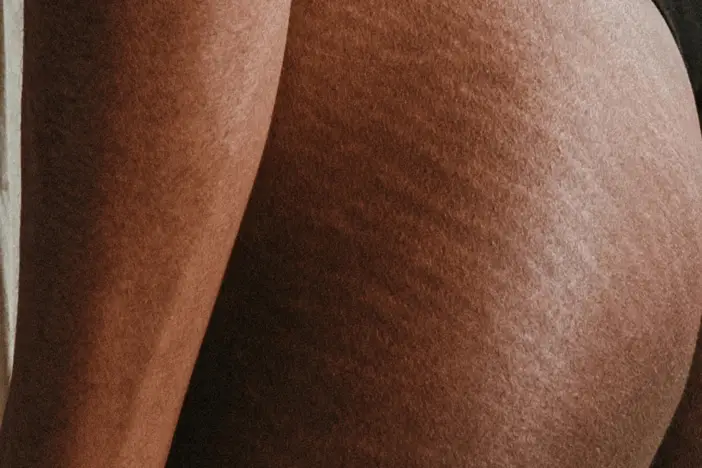Stretch marks, also called Striae, are scars on the skin that resemble stretchy, pinkish lines.
They are caused by great changes in the skin’s tissue, usually in the dermis.
Stretch mark does not have an environmental or hereditary cause, although they can sometimes be hereditary.
This means that the more you have family members that have stretch marks, the higher you’re at risk.
Some other causes of stretch marks are; insufficient hydration, hormonal changes such as during puberty or pregnancy and rapid weight loss/gain.
While they may look alarming and appear suddenly, they are not at all dangerous to your health.
However, we shall examine the causes and some effective ways to get rid of them.
Causes Of Stretch Mark
Stretch marks can be caused by but not limited to the following;
1. Pregnancy
Pregnancy stretch marks, also known as Striae gravidarum, are a skin condition that occurs during pregnancy and can leave unsightly marks on your body.
While they can be seen in any location on the body, one of the more common areas for which this skin condition is seen is the abdomen of pregnant mothers.
Stretch marks are caused when there is an increase in cortisone and estrogen during pregnancy due to the increased blood supply to your abdomen.
2. Rapid Weight loss or gain
If you are experiencing rapid weight gain or loss the most common side effect will be stretch marks.
Stretch marks come from new skin growth at a faster rate than the cells can naturally produce.
The result is uneven skin that forms lines or bands across your body where the skin has stretched. Weight gain and weight loss are both major reasons people struggle with stretch marks.
3. Hormonal Changes
The reason behind this is a high amount of estrogen and progesterone.
When these hormones are too much concerning each other, it causes distended blood vessels under the skin.
This causes the rapid growth of connective tissues there, where a lot of fat accumulates.
As a result, it creates stretch marks on different parts of your body.
4. Overuse of steroids
Steroids can cause several serious health problems, which is why they should be used with caution and for medical reasons only.
Stretch marks can result from the overuse of steroids. These marks are caused by the rupturing of elastic fibres under the surface of the skin.
This is particularly common in areas of the body where muscles grow at an accelerated rate such as the pectorals, deltoid muscles and thighs.
5. Medication
Some stretch marks can be caused by medications such as chemotherapy drugs or steroids that treat conditions, including severe allergies, asthma, eczema, and arthritis.
Many doctors believe that even though the exact cause of stretch marks remains unknown; they are not uncommon in women.
Similarly, it is common in women who put their health at risk while pregnant.
For example, using high doses of drugs such as steroids or withdrawal from certain anti-seizure medications.
6. Family History
Stretch marks are not hereditary but the propensity to develop them may be inherited if one of your parents has such marks.
When the skin and underlying tissue are put under pressure from rapid growth, the elastin and collagen supply isn’t adequate to keep up with the skin’s demand for elasticity, and marked stretching occurs.
If your mother has stretch marks then it is likely that you will have some of your own during puberty.
Stretch marks caused by family history usually appear on the hips, thighs, breasts, buttocks or stomach.
This means that stretch marks are not hereditary but there is a tendency for your body to function closely.
Each individual inherits different genes from their parents and they determine who develops stretch marks and who doesn’t.
How to Get Rid of Stretch Marks
1. Use coconut oil to help with skin elasticity
2. Moisturize
3. Wear support garments during and after pregnancy
4. Consume a healthy diet
5. Talk to your doctor about stretch mark removal creams
6. Exercise frequently
7. Use Vitamin E oil
8. Stretch mark removal
1. Use Essential oils
There is a simple home remedy to make them disappear with the use of essential oils.
One of the most effective essential oils for stretch marks is lavender oil.
Does stretch mark go away with essential oils?
It helps reduce the appearance of the stretch marks and fades their color along with it.
2. Moisturize
Who would have thought that moisturizers can help get rid of stretch marks?
But the fact is yes it can.
With the use of different types of moisturizers, you can help with treating and preventing stretch marks.
You will be surprised to learn how much these moisturizers can do for you.
Moisturizers that contain Retin-A (Vitamin A) and Vitamin C are recommended.
3. Wear support garments during and after pregnancy
Many new mothers are keen to get rid of stretch marks during pregnancy.
They could appear when the skin stretches faster than it can grow.
But what is the best way to get rid of them?
When you wear support garments in pregnancy, your chances of getting stretch marks will be reduced.
4. Consume a healthy diet
Several ways can help get rid of stretch marks.
Eating a healthy diet is one good way.
Changing your diet doesn’t necessarily involve putting yourself through the pain of starvation.
Instead, it means adding healthy food alternatives to your current meals.
5. Exercise frequently
Since stretch marks can occur when there is rapid weight gain.
As a result, it is important to exercise frequently to prevent such a sudden, rapid increase in weight.
6. Use Vitamin E
Vitamin E is a must-have for your skincare routine, and not just during pregnancy.
It’s an anti-oxidant and anti-inflammatory which makes it perfect for preventing stretch marks if it’s used shortly after gaining weight or giving birth.
7. Stretch Mark removal creams
Stretch marks remover cream is an effective way to get rid of stretch marks.
These creams work by boosting collagen and elastin in your skin to help promote a healthy and vibrant glow to your skin.
Does stretch mark go away with removal creams?
While these creams may be effective, it is important to consult your doctor on the possible side effects.
It is also important to know what chemicals or ingredients to avoid in these creams.

FAQ’s About Stretch Marks
How do you get rid of stretch marks on your inner thighs?
Stretch marks on the inner thighs can appear because the skin in this area is very elastic.
It is stretched strongly under the influence of hormones during pregnancy, which leads to its stretching.
In pregnant women, these stretch marks are relatively common.
Some of the things that will help with your stretch marks are;
2. Eat foods that have antioxidants
3. Use those products that contain cocoa butter, vitamin E and jojoba oil to soften the skin.
4. Avoid taking long and hot baths or showers and applying serums to soften your skins.
5. Use an emollient lotion with dimethicone on any areas of raised stretch marks.
Is cocoa butter good for removing dark spots and stretch marks?
No, research has shown that cocoa butter is not effective for removing stretch marks and dark spots.
So does stretch mark go away with constant use of cocoa butter?
The short answer is that it can soften your skin and help you reduce the possibilities of getting them.
This is because it contains a high content of stearic acid.
Stearic acid is the saturated fat that helps to break down the stretch marks by making them smaller and finer.
By also moisturizing, it makes the skin smoother and softer with an even color.
Conclusion
The stretch mark removal process is a time consuming one, but it can be done.
To get rid of your stretch marks you must take continuous action and be consistent with your use of the mentioned methods.
When starting the stretch mark removal treatment, you will need to be patient because it will take a while for results to show.
However, you can be sure to get a flawless skin in a short period.







